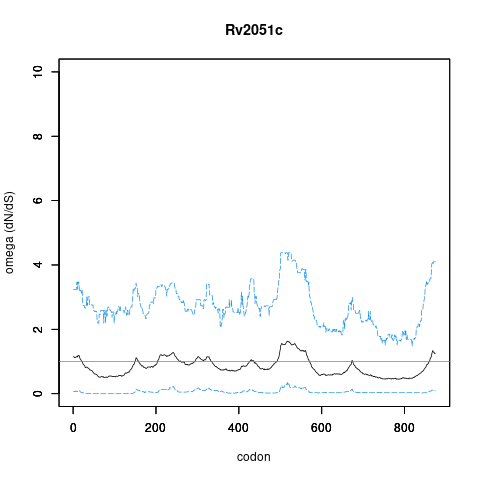| Property | Value | Creator | Evidence | PMID | Comment |
| Citation | Ppm1, a novel polyprenol monophosphomannose synthase from Mycobacterium tuberculosis. SS. Gurcha, AR. Baulard et al. Biochem. J. 2002 | njamshidi | ISS | 11931640|15228522 | known to occur physiologically (see Tuberculist for example - also demonstrated biochemically see PMID: 11931640, 15228522) - specific biochemical mechanism has not been elucidated. |
| Term | TBRXN:GMT2 gdp mannosyl phosphate transferase - ISS | njamshidi | ISS | 11931640|15228522 | known to occur physiologically (see Tuberculist for example - also demonstrated biochemically see PMID: 11931640, 15228522) - specific biochemical mechanism has not been elucidated.
SS. Gurcha, AR. Baulard et al. Ppm1, a novel polyprenol monophosphomannose synthase from Mycobacterium tuberculosis. Biochem. J. 2002 |
| Citation | Mycobacterial lipoarabinomannan and related lipoglycans: from biogenesis to modulation of the immune response. authors,V. Briken,SA. Porcelli,GS. Besra,L. Kremer Mol. Microbiol. 2004 | njamshidi | ISS | 11931640|15228522 | known to occur physiologically (see Tuberculist for example - also demonstrated biochemically see PMID: 11931640, 15228522) - specific biochemical mechanism has not been elucidated. |
| Term | TBRXN:GMT2 gdp mannosyl phosphate transferase - ISS | njamshidi | ISS | 11931640|15228522 | known to occur physiologically (see Tuberculist for example - also demonstrated biochemically see PMID: 11931640, 15228522) - specific biochemical mechanism has not been elucidated.
authors,V. Briken,SA. Porcelli,GS. Besra,L. Kremer Mycobacterial lipoarabinomannan and related lipoglycans: from biogenesis to modulation of the immune response. Mol. Microbiol. 2004 |
| Citation | Ppm1, a novel polyprenol monophosphomannose synthase from Mycobacterium tuberculosis. SS. Gurcha, AR. Baulard et al. Biochem. J. 2002 | njamshidi | IPI | 11931640|15228522 | known to occur physiologically (see Tuberculist for example - also demonstrated biochemically see PMID: 11931640, 15228522) - specific biochemical mechanism has not been elucidated. |
| Term | TBRXN:GMT2 gdp mannosyl phosphate transferase - IPI | njamshidi | IPI | 11931640|15228522 | known to occur physiologically (see Tuberculist for example - also demonstrated biochemically see PMID: 11931640, 15228522) - specific biochemical mechanism has not been elucidated.
SS. Gurcha, AR. Baulard et al. Ppm1, a novel polyprenol monophosphomannose synthase from Mycobacterium tuberculosis. Biochem. J. 2002 |
| Citation | Mycobacterial lipoarabinomannan and related lipoglycans: from biogenesis to modulation of the immune response. authors,V. Briken,SA. Porcelli,GS. Besra,L. Kremer Mol. Microbiol. 2004 | njamshidi | IPI | 11931640|15228522 | known to occur physiologically (see Tuberculist for example - also demonstrated biochemically see PMID: 11931640, 15228522) - specific biochemical mechanism has not been elucidated. |
| Term | TBRXN:GMT2 gdp mannosyl phosphate transferase - IPI | njamshidi | IPI | 11931640|15228522 | known to occur physiologically (see Tuberculist for example - also demonstrated biochemically see PMID: 11931640, 15228522) - specific biochemical mechanism has not been elucidated.
authors,V. Briken,SA. Porcelli,GS. Besra,L. Kremer Mycobacterial lipoarabinomannan and related lipoglycans: from biogenesis to modulation of the immune response. Mol. Microbiol. 2004 |
| Citation | Ppm1, a novel polyprenol monophosphomannose synthase from Mycobacterium tuberculosis. SS. Gurcha, AR. Baulard et al. Biochem. J. 2002 | njamshidi | ISS | 11931640|15228522 | known to occur physiologically (see Tuberculist for example - also demonstrated biochemically see PMID: 11931640, 15228522) - specific biochemical mechanism has not been elucidated. |
| Term | TBRXN:GMT1 gdp mannosyl phosphate transferase - ISS | njamshidi | ISS | 11931640|15228522 | known to occur physiologically (see Tuberculist for example - also demonstrated biochemically see PMID: 11931640, 15228522) - specific biochemical mechanism has not been elucidated.
SS. Gurcha, AR. Baulard et al. Ppm1, a novel polyprenol monophosphomannose synthase from Mycobacterium tuberculosis. Biochem. J. 2002 |
| Citation | Mycobacterial lipoarabinomannan and related lipoglycans: from biogenesis to modulation of the immune response. authors,V. Briken,SA. Porcelli,GS. Besra,L. Kremer Mol. Microbiol. 2004 | njamshidi | ISS | 11931640|15228522 | known to occur physiologically (see Tuberculist for example - also demonstrated biochemically see PMID: 11931640, 15228522) - specific biochemical mechanism has not been elucidated. |
| Term | TBRXN:GMT1 gdp mannosyl phosphate transferase - ISS | njamshidi | ISS | 11931640|15228522 | known to occur physiologically (see Tuberculist for example - also demonstrated biochemically see PMID: 11931640, 15228522) - specific biochemical mechanism has not been elucidated.
authors,V. Briken,SA. Porcelli,GS. Besra,L. Kremer Mycobacterial lipoarabinomannan and related lipoglycans: from biogenesis to modulation of the immune response. Mol. Microbiol. 2004 |
| Citation | Ppm1, a novel polyprenol monophosphomannose synthase from Mycobacterium tuberculosis. SS. Gurcha, AR. Baulard et al. Biochem. J. 2002 | njamshidi | IPI | 11931640|15228522 | known to occur physiologically (see Tuberculist for example - also demonstrated biochemically see PMID: 11931640, 15228522) - specific biochemical mechanism has not been elucidated. |
| Term | TBRXN:GMT1 gdp mannosyl phosphate transferase - IPI | njamshidi | IPI | 11931640|15228522 | known to occur physiologically (see Tuberculist for example - also demonstrated biochemically see PMID: 11931640, 15228522) - specific biochemical mechanism has not been elucidated.
SS. Gurcha, AR. Baulard et al. Ppm1, a novel polyprenol monophosphomannose synthase from Mycobacterium tuberculosis. Biochem. J. 2002 |
| Citation | Mycobacterial lipoarabinomannan and related lipoglycans: from biogenesis to modulation of the immune response. authors,V. Briken,SA. Porcelli,GS. Besra,L. Kremer Mol. Microbiol. 2004 | njamshidi | IPI | 11931640|15228522 | known to occur physiologically (see Tuberculist for example - also demonstrated biochemically see PMID: 11931640, 15228522) - specific biochemical mechanism has not been elucidated. |
| Term | TBRXN:GMT1 gdp mannosyl phosphate transferase - IPI | njamshidi | IPI | 11931640|15228522 | known to occur physiologically (see Tuberculist for example - also demonstrated biochemically see PMID: 11931640, 15228522) - specific biochemical mechanism has not been elucidated.
authors,V. Briken,SA. Porcelli,GS. Besra,L. Kremer Mycobacterial lipoarabinomannan and related lipoglycans: from biogenesis to modulation of the immune response. Mol. Microbiol. 2004 |


